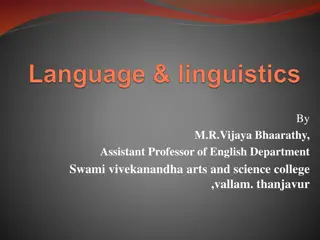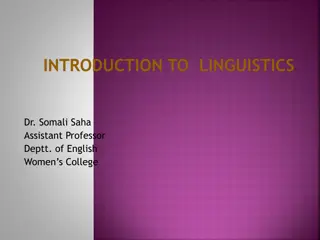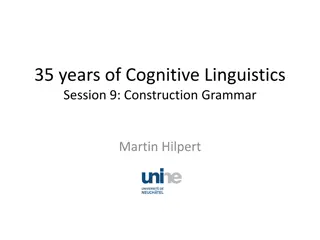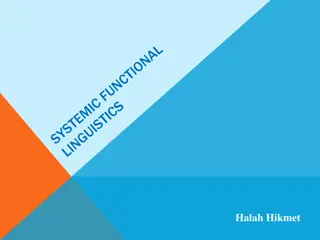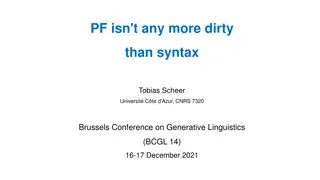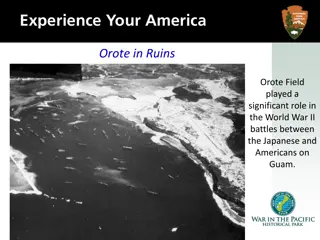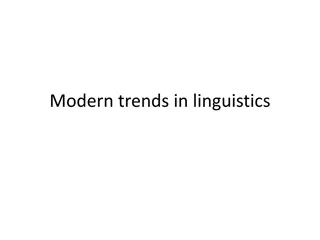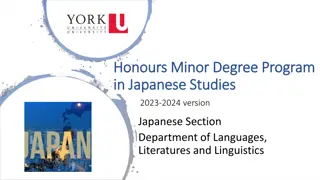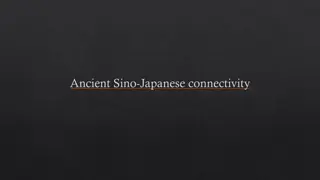Dependent Case Theory in Japanese Linguistics
Dependent case theory challenges traditional views on case assignment, particularly in the context of Japanese grammar. This theory argues for a different approach to case assignment based on interpretative processes rather than licensing conditions. The theory is explored in-depth, discussing necessary modifications for Japanese grammar and why it is considered a valuable theoretical framework. Various aspects of case assignment, types of cases, and their relevance in different linguistic contexts are examined, shedding light on the complexities of case phenomena in Japanese linguistics.
Download Presentation

Please find below an Image/Link to download the presentation.
The content on the website is provided AS IS for your information and personal use only. It may not be sold, licensed, or shared on other websites without obtaining consent from the author.If you encounter any issues during the download, it is possible that the publisher has removed the file from their server.
You are allowed to download the files provided on this website for personal or commercial use, subject to the condition that they are used lawfully. All files are the property of their respective owners.
The content on the website is provided AS IS for your information and personal use only. It may not be sold, licensed, or shared on other websites without obtaining consent from the author.
E N D
Presentation Transcript
Dependent case in Japanese Satoru Ozaki Carnegie Mellon University
Big picture 1. Dependent case theory is a good theory 2. But it doesn t work for Japanese 1. NOM/ACC case alternation on the object 2. DAT/NOM case alternation on the subject 3. What are the necessary modifications? 4. For Japanese, why is dependent case theory the best theoretical option among others?
Intro to dependent case theory (DCT) Theory if case proposed by Marantz (1991), Baker (2015), etc. How is it different from Chomskian theories of case?
Big diff: Case assignment is not licensing but an interpretative process Linearization (LCA) Case Filter Visibility condition Distributed Morphology Case-features are uninterpretable Unvalued phi- features are uninterpretable Case assignment Licensing conditions Interpretative process
When/where does Case assignment happen? Just like phi-feature Agree(ment) Just like linearization Chomskian Case Theory: Anytime during the derivation when there is Agree(ment) between a Probe and a Goal Dependent case theory: During Spell-Out of a category that contains something that can receive case, e.g. DP/NP
Different types of cases Lexical case e.g. quirky cases in Icelandic, adpositions Dependent case e.g. accusative (ACC), ergative (ERG) Unmarked case (last resort) e.g. nominative (NOM)/absolutive (ABS), genitive (GEN) most specific most preferred least specific least preferred
Dependent case: ACC, ERG Accusative languages ACC assignment If DP1 c-commands DP2 in a TP, assign ACC to DP2. ERG assignment If DP1 c-commands DP2 in a TP, assign ERG to DP1. Only applies when there are 2 argumental DPs in a clause Ergative languages
Case availability as a parameter Accusative languages Only ACC is available Ergative languages Only ERG is available Tripartite languages Both ACC and ERG available Rude (1986) (cited by Baker 2015) If ACC is available If ERG is available Intransitive subject N/A N/A Transitive subject ergative N/A Transitive object accusative N/A
Applying DCT to Japanese Japanese is an accusative language (?) Consider: Intransitive Daisuke ga okotta. Daisuke NOM became.angry Daisuke became angry. Transitive Shoohei ga raamen o tabeteiru. Shohei NOM ramen ACC is.eating Shohei is eating ramen.
Intransitive (Step 2/4): VP spell-out No cases assigned because no DPs within the VP
Intransitive (Step 3/4): Build CP Assuming EPP of subject but this doesn t matter
Intransitive (Step 4/4): TP spell-out What case is assigned to Daisuke? Lexical case No lexical assigner. Dependent case No c-command relations. Unmarked case NOM is the unmarked case in a TP.
Transitive (Step 2/4): VP spell-out Why doesn t the object get NOM? Because unmarked case is a last resort. ACC assignment happens at TP spell-out, so the object can wait until then. ACC assignment If DP1 c-commands DP2 in a TP, assign ACC to DP2.
Transitive (Step 4/4): TP spell-out What case is assigned to raamen? Lexical case No lexical assigner. Dependent case c-commanded by Shoohei. Unmarked case
Problematic data: object case alternation (1/2) Most transitive verbs only allow either NOM or ACC on the object, i.e. the choice of object case is not free. taberu eat : raamen *ga/o tabe-ru ramen *NOM/ACC eat-PRES I eat ramen. mieru can see : fujisan ga/*o mie-ru Mt.Fuji NOM/*ACC can.see-PRES I can see Mt. Fuji.
Problematic data: object case alternation (2/2) Desiderative/potential forms of certain verbs allow NOM/ACC alternation: tabe-tai want to eat : raamen ga/o tabe-ta-i. ramen NOM/ACC eat-DES-PRES I want to eat ramen. mie-tai want to be able to see : (hachi no yooni) shigaisen ga/*o (like bees) UV.light NOM/*ACC can.see-DES-PRES I want to be able to see UV light (like bees). tabe-(ra)reru be able to eat : serori ga/o tabe-(ra)re-na-i celery NOM/ACC eat-POT-NEG-PRES I can t eat celeries. mie-ta-i.
Japanese case assignment patterns Pattern NOM NOM-ACC NOM-NOM Can we get it in DCT? We need to be able to generate this
A similar problem in Baker (2015) Languages vary in how they mark the indefinite object (theme) in ditransitive constructions. Cuzco Quechua NOM-DAT-ACC Sakha NOM-DAT-NOM
Can the object wait until TP spell out? Recall that in the derivation of NOM-ACC, the object was allowed to wait until TP spell out to get ACC, which is preferred over NOM. But if the object is not allowed to wait and must get case immediately, the object should receive NOM. Wait to get ACC Don t wait, just get NOM
v as hard or soft phase head Cuzco Quechua has a soft v* Baker (2015, 149): If v is a hard phase head, then the contents of its VP complement are invisible for the subsequent syntactic derivation after spelling out. If v is a soft phase head, then the contents of its VP complement undergo spell out (e.g. they may get their case features fixed) but they remain active in the derivation. Object can wait for ACC Sakha has a hard v* Object must get NOM now
Apply this to Japanese Verb (stem)s are only selected by one kind of v*. If a verb V is selected by soft v* only, then V+DES is selected by both kinds of v*. Hard v* NOM on object. Soft v* ACC on object.
DES is selected by a hard v* A stronger conclusion from: If a verb V is selected by soft v* only, then V+DES is selected by both kinds of v*. Why? We have the verb mieru, which is selected by hard v* only: mie-tai can.see-DES;want to be able to see : (hachi no yooni) shigaisen ga/*o (like bees) UV.light NOM/*ACC can.see-DES-PRES I want to be able to see UV light (like bees). mie-ta-i.
Motivation for the soft/hard distinction? Baker (2015) doesn t have to provide this, but we have to
Jacobsen (2018): ACC intentionality Jacobsen (2018, 17): The presence of intentional meaning is a necessary condition on the occurrence of accusative o. Subject intentionality tests Deguchi o sagas-e / sagas-e-nai / sagas-ou! Exit ACC look.for-IMP / look.for-POT-NEG / look.for-VOL Look for the exit! / I can t look for the exit. / Let s look for the exit! Kotae ga #wakar-e / #wakar-e-nai / #wakar-ou! Answer NOM get-IMP / get-POT-NEG / get-VOL #Get the answer! / #I can t get the answer. / #Let s get the answer!
Motivation for the soft/hard distinction Soft v* induces an intentional reading on the subject. What about hard v*? (In progress) could be other properties, e.g. stativity.
Problematic data: subject case alternation Certain verbs allow DAT/NOM alternation on the subject and assigns NOM to the object: hitsuyoo-da need : Jun ni/ga okane Jun DAT/NOM money NOM Jun needs money. kikoeru can hear : Kaoru ni/ga henna Kaoru DAT/NOM strange sound Kaoru is hearing strange sounds. dekiru be able to : Uma ni/ga kuchikokyuu horse DAT/NOM mouth.breathing NOM Horses can t breathe through their mouths. ga hitsuyoo necessary COP da. oto ga NOM kikoeru. can.hear ga deki-nai be.able.to-NEG
Other occurrences of subject DAT (Syntactic) causatives Watashi ga I I made the kids clean the room. Expressing desire with te form + hoshii want Watashi ga kodomo ni I NOM child I want the kids would clean the room. ni-passives Kentaro ga ie Kentaro NOM house Kentaro got kicked out from the house. kodomo ni child heya o sooji-sase-ta. DAT room ACC clean-CAUSE-PAST NOM heya o sooji-shite-hoshii. DAT room ACC clean-do-want kara oidas-are-ta. ABL kick.out-PASS-PAST
DAT in DCT Baker (2010, 2015) considers similar psych/possessive verbs in Sakha, Ingush, Tamil with DAT-NOM and DAT-ACC patterns DAT on subject can come from: Dependent case assignment: If NP1 c-commands NP2 in a VP, assign DAT to NP1. PP subject: Certain adpositions assign DAT to its complement as lexical case.
Sources of subject DAT (in progress) Syntactic causatives Kodomo ni heya o sooji saseta. I made the kids clean the room. DAT/NOM alternation Jun ni okane ga hitsuyoo da. Jun needs money. ni-passives Kentaro ga ie kara oidasareta. Kentaro got kicked out from the house. te form + hoshii want Kodomo ni heya o sooji shite hoshii. I want the kids to clean the room. DAT by dependent case DAT by adposition
Sources of subject DAT (in progress) Experiencer subjects do not raise out of [Spec; VP] position EPP-movement to [Spec; TP] is unnecessary for non-finite VPs DAT/NOM alternation Jun ni okane ga hitsuyoo da. Jun needs money. te form + hoshii want Kodomo ni heya o sooji shite hoshii. I want the kids to clean the room. DAT by adposition
Sources of subject DAT (in progress) Causativization and passivization are valency operations, which are syntactic alternations Syntactic causatives Kodomo ni heya o sooji saseta. I made the kids clean the room. ni-passives Kentaro ga ie kara oidasareta. Kentaro got kicked out from the house. DAT by dependent case
Why is DCT better than Agree-based theory? Inherent advantages of using DCT Japanese doesn t have overt agreement DCT covers a wide variety of language already Theoretical advantages Elimination of Case-features from narrow syntax Better explanation between object case and semantic property of agent
Case-features and uninterpretability The ideal definition of uninterpretability: A feature is uninterpretable iff it is unvalued. Case-features break this definition while everything else don t Phi-features Wh-features EPP-features
Explaining the ACC intentionality observation In an Agree-based theory, v* is responsible for selecting an agent V is responsible for case assignment to object This separation of roles makes it difficult to explain Jacobsen s observation verbs that assign ACC have an intentional agent Inheritance from v* to V does exist, but is very stipulative (Tonoike 2019)
Explaining the ACC intentionality observation In our DCT-based approach, this receives a nice explanation Soft v* induces intentionality, while hard v* does not A syntactic property is linked with a semantic property
Selected references Baker, Mark, and Nadezhda Vinokurova. Two modalities of case assignment in Sakha. In Natural Language and Linguistic Theory, 28:593 642, 2010. Baker, Mark. Case: Its Principles and its Parameters. Cambridge University Press, 2015. Jacobsen, Wesley M. Transitivity. In Masayoshi Shitabani, Shigeru Miyagawa, and Hisashi Noda, editors, Handbook of Japanese Syntax, pages 55 96. De Gruyter Mouton, 2018. Marantz, Alec. Case and licensing. In Proceedings of the Eighth Eastern States Conference on Linguistics, pages 234 253. Ohio State University, 1991. Rude, Noel. Topicality, transitivity and the direct object in Nez Perce. In International Journal of American Linguistics, 52:124 153. 1986. Tonoike, Shigeo. Minimarisuto nichieigo hikaku tougoron (Minimalist Japanese-English comparative syntax). Kaitakusha, 2019.






